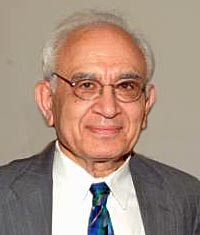Thomas L. Saaty
Thomas L. Saaty is an American mathematician serving as University Professor at the University of Pittsburgh Joseph M. Katz Graduate School of Business & College of Business Administration. He is the inventor, architect, and primary theoretician of the Analytic Hierarchy Process, a decision-making framework used for large-scale, multiparty, multicriteria decision problems, and of the Analytic Network Process, its generalization to decisions with dependence and feedback.
Dr. Saaty has made contributions in the fields of operations research (parametric linear programming, epidemics and the spread of biological agents, queuing theory, and behavioral mathematics as it relates to operations), arms control and disarmament, and urban design. He has written 33 books and over 300 papers on mathematics, operations research, and decision making. Their subjects include graph theory and its applications, nonlinear mathematics, analytical planning, and game theory and conflict resolution.
Among other honors, Saaty has been elected to the National Academy of Engineering (2005), the Real Academia de Ciencias Exactas, Físicas y Naturales (Spanish Royal Academy of Sciences, 1971), and as a Fellow of the American Association for the Advancement of Science (1956). In 1973, he received the Lester R. Ford award from the Mathematical Association of America for his work on the four color problem, and in 2000 he was awarded the gold medal of the International Society on Multi-criteria Decision Making. He is the 2007 recipient of the Akao Prize of the QFD Institute.
Prior to coming to the University of Pittsburgh, Dr. Saaty spent ten years as a professor at the Wharton School, University of Pennsylvania. Prior to that, he spent fifteen years working for U.S. government agencies and for companies doing government-sponsored research. His employers at that time included the Operations Evaluation Group of MIT at the Pentagon, the Office of Naval Research, and the Arms Control and Disarmament Agency at the U.S. State Department.
Degrees
PhD, Mathematics, Yale University, 1953 (thesis, under Einar Hille: "On the Bessel Tricomi Equation"). Post-graduate study, University of Paris, 1952-53. MA, Mathematics, Yale University, 1951. MS, Physics, Catholic University of America, 1949. BA, Columbia Union College, 1948.
References and external links
- TEMPORARY LINK TO ELSEWHERE
- University of Pittsburgh faculty biography
- University of Pittsburgh Joseph M. Katz School
- National Academy of Sciences membership listing
- Real Academia de Sciencios, Relación de Académicos
- Mathematical Association of America
- International Society on Multi-criteria Decision Making
- QFD Institute
